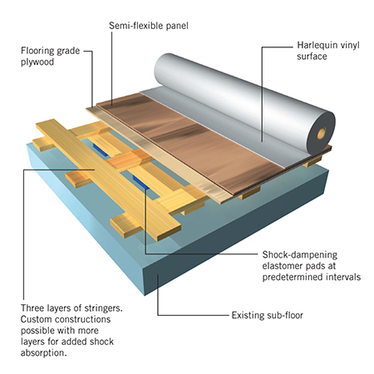 Dancing at home has presented new challenges such as having to adjust to improper flooring and/or investing in new flooring. With this in mind, what flooring is appropriate? What are some indications that I may be dancing on improper flooring? What can I do to modify if I don’t currently have access to good flooring? Good technique and adequate flooring are both crucial for injury prevention. Up to 28% of professional dancers associated an unsuitable floor surface with re-injury (Hopper 2014). A permanent, fully sprung floor is recommended (Quin 2015). This translates into a 2 component structure. The top surface is typically wood or marley in order to provide optimal grip. Too much resistance can create added torque on joints, while lack of friction leads to increased muscular tension and falls. The undersurface/substructure has the shock absorbing properties and typically consists of a solid or suspended subfloor with a dense foam layer underneath (Quin 2015). It is also important to note that raked stages can triple the amount of risk for injury. In addition, floor surface variability versus lack of shock absorbing capabilities may have an even greater influence on injury (Hopper 2014). Therefore, it is important to maintain uniformity of the surface and clean regularly. Improper flooring can contribute to low back pain, sacroiliac dysfunction, stress fractures, shin splints, and tendinopathies. Occurrence of these injuries could indicate improper flooring. If you don’t have immediate access to a sprung floor, you may want to consider the following: jumping in sneakers, avoiding single leg landings, close in first or third position rather than fifth position, and/or train the components of the jumps. References: Hopper, L. S., Allen, N., Wyon, M., Alderson, J. A., Elliott, B. C., & Ackland, T. R. (2014). Dance floor mechanical properties and dancer injuries in a touring professional ballet company. Journal of science and medicine in sport, 17(1), 29-33. Quin, Edel & Rafferty, Sonia & Tomlinson, Charlotte. (2015). Safe Dance Practice: An applied dance science perspective. Pages 8-10.
4 Comments
|
CategoriesAll Cross Training Injury Prevention Nutrition Recipes Wellness Archives
October 2021
|
 RSS Feed
RSS Feed